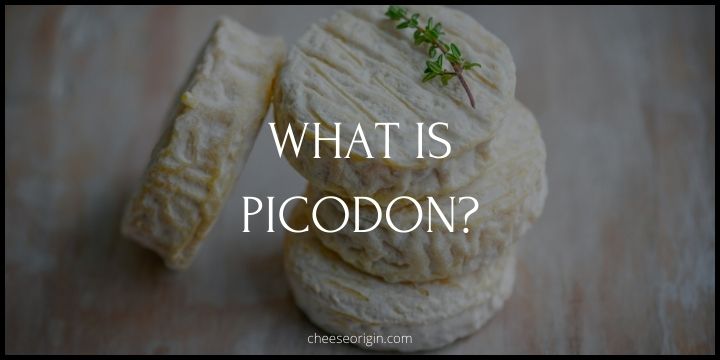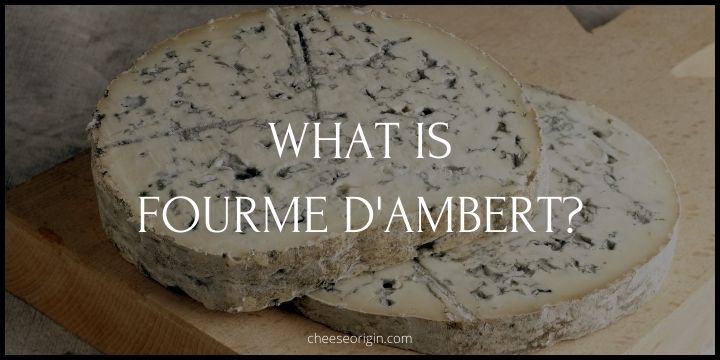What is Bleu de Termignon? A Rare French Delight from the Alps
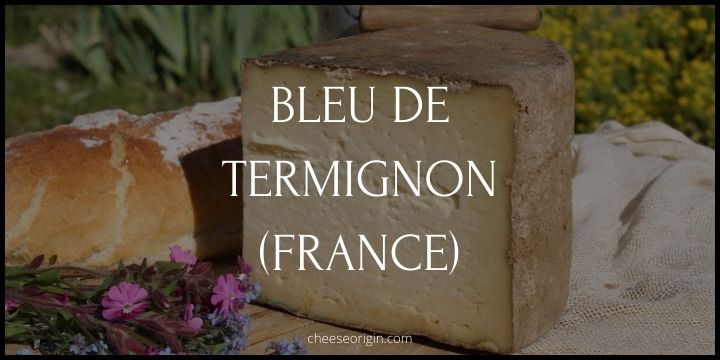
Welcome to our exploration of Bleu de Termignon, a rare gem in the world of cheese. This exquisite blue cheese hails from the pristine Alpine pastures of France and represents an art of cheesemaking that has remained virtually unchanged for centuries.
Crafted with a devotion to tradition and a deep respect for the land, Bleu de Termignon is a testament to the power of simplicity and patience.
With only a handful of dedicated farmers continuing to make this cheese in the traditional way, each wheel is a celebration of heritage, authenticity, and extraordinary flavor.
In this post, we’ll delve into the fascinating journey of Bleu de Termignon, from the lush high-altitude meadows where its story begins, to the delight of savoring its complex, layered taste.
Whether you’re a seasoned cheese connoisseur or a curious foodie, prepare to be enchanted by the charm of this rare French delight from the Alps.
Quick Facts About Bleu de Termignon
| Country of Origin | France |
| Region | Termignon, Savoie, Rhône-Alpes |
| Age | 4 to 5 months |
| Milk | Unpasteurized cow’s milk |
| Classification | Blue |
| Weight & Shape | 7 kg (15.5 lb), drum |
| Size | Diameter 29 cm (11.75 inches), Height 15 cm (6 inches) |
| Producer | Various |
| Taste | Strong, spicy, tang, earthy, refined |
| Texture | Rough crusty exterior, crumbly interior |
| Pairing | Valpolicella, Merlot, Gigondas, Chignin Bergeron, Vacqueyras, Chignin Bergeron |
| Production Season | Traditionally made in summer and early autumn |
| Fun fact | Each wheel is handcrafted by a small number of producers. It’s one of the rarest cheeses in France. |
What is Bleu de Termignon?
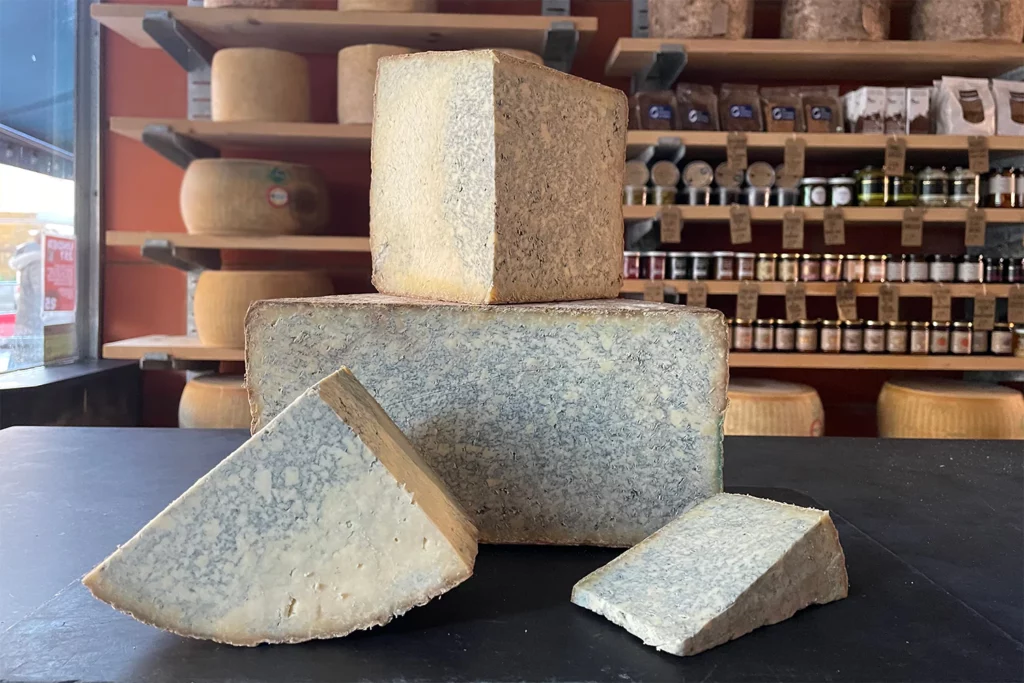
Bleu de Termignon is a remarkable blue cheese that hails from the eastern part of the French Alps, close to the Italian border. This cheese is a raw, blue mold variety, handcrafted by a select few cheesemakers who are committed to preserving this rare piece of gastronomic heritage.
This cheese is produced from the milk of Tarine and Abondance cows, which graze on the lush alpine pastures of Termignon in Savoie. The cheese wheels measure 40cm and weigh approximately 6kg.
One of the unique features of Bleu de Termignon is its natural blue veins. Unlike many blue cheeses, it’s not pierced or seeded to encourage the growth of mold. Instead, the blue mold develops naturally during the maturation process.
Bleu de Termignon is produced by hand at an altitude of 2300 m above sea level, in a handful of mountain chalets in the heart of the Alps. This artisanal production method contributes to the cheese’s distinctive flavor and rarity.
Despite its limited production, Bleu de Termignon is highly sought after by cheese connoisseurs. It’s known for its robust flavor, which mirrors the rich biodiversity of the alpine pastures where its main ingredient, cow’s milk, comes from.
It’s a seasonal cheese, produced from June to September, when the cows can graze on the fresh alpine grass. This seasonality adds another layer of exclusivity to this already rare cheese.
In summary, Bleu de Termignon is a testament to traditional cheesemaking techniques. Its unique flavor profile, natural blue veins, and the dedication of a handful of cheesemakers make it one of France’s most exceptional cheeses.
Did you know?
The irregular blueing is not the result of piercing, but of wild molds entering through cracks of the rind. Read The Science of Cheese-making to learn more.
What Does Bleu de Termignon Taste Like?
Bleu de Termignon is a cheese celebrated for its complex and nuanced flavor profile. The taste can vary based on the age of the cheese, but it generally presents a harmonious blend of tangy, fruity, and mildly spicy notes.
When you first taste Bleu de Termignon, you’ll likely notice a sharp, tangy flavor that’s characteristic of blue cheeses. This is followed by an undercurrent of fruitiness, reminiscent of wild berries. As the cheese ages, it tends to develop a nutty undertone that adds another layer of complexity to its flavor.
Despite being a blue cheese, Bleu de Termignon isn’t overwhelmingly pungent or peppery. Instead, it has a mild spiciness that doesn’t overpower its other flavors. It also has a hint of earthiness, reflecting the alpine pastures where the cows graze.
The cheese has a semi-soft, crumbly texture that melts in the mouth, releasing its rich and varied flavors. The rind, which is edible, adds a slightly bitter note that contrasts beautifully with the creaminess of the cheese.
Overall, Bleu de Termignon offers a sophisticated flavor journey that can be enjoyed on its own or paired with sweet wines, fresh fruits, or crusty bread.
Bleu de Termignon Tasting Notes
- Appearance: The cheese has a natural, edible rind that is grayish-brown in color. Inside, the paste is a creamy, pale yellow with distinctive blue veins running through it.
- Texture: Semi-soft and crumbly but can be creamy when it reaches room temperature. It melts smoothly in the mouth.
- Aroma: The cheese carries an earthy aroma, reminiscent of the alpine pastures where the cows graze. There may also be subtle hints of barnyard and fresh milk.
- Taste: The initial taste is tangy and sharp, characteristic of blue cheeses. This is followed by fruity notes, evocative of wild berries or ripe stone fruits.
- Aftertaste: As the cheese matures, it develops a nutty undertone that lingers in the aftertaste. There’s also a mild spiciness that doesn’t overpower the other flavors.
- Rind: The rind is edible and adds a slightly bitter note to the overall flavor profile, providing a nice contrast to the creamy interior.
- Pairings: Bleu de Termignon pairs well with sweet wines like Sauternes or late-harvest Riesling. It also goes well with fresh fruits like pears and apples or can be enjoyed with crusty bread.
- Mouthfeel: Despite its crumbly texture, the cheese has a creamy mouthfeel that leaves a pleasant, buttery sensation.
What Goes Well With Bleu de Termignon?
Food that goes well with Bleu de Termignon:
| Category | Food Pairing |
|---|---|
| Fruits | Pears, Apples, Figs, Grapes, Dried Apricots |
| Nuts | Walnuts, Almonds, Hazelnuts |
| Breads | Baguette, Walnut Bread, Rye Bread |
| Meats | Prosciutto, Salami, Smoked Duck Breast |
| Jams and Spreads | Fig Jam, Quince Paste, Honey |
| Desserts | Dark Chocolate, Tarte Tatin, Blueberry Tart |
| Vegetables | Roasted Beets, Grilled Peppers, Caramelized Onions |
| Grains and Pulses | Quinoa, Lentils, Farro |
| Seafood | Smoked Salmon, Anchovies, Seared Scallops |
Also read: What Fruit Goes on a Charcuterie Board?
Beverage that goes well with Bleu de Termignon:
| Category | Beverage Pairing |
|---|---|
| Wines | Sauternes, Port, Riesling, Late Harvest Wines, Merlot, Valpolicella |
| Spirits | Whisky, Brandy, Armagnac |
| Beers | Belgian Trappist Beers, Stout, Brown Ale |
| Ciders | Dry Cider, Pear Cider |
| Non-Alcoholic Drinks | Sparkling Water, Grape Juice, Apple Juice |
Also read: Best Wine and Cheese Pairings: The Ultimate Guide
Pairing wine of the same region, such as Gigondas, Chignin Bergeron, and Vacqueyras, will be exactly how the French will pair with this cheese.
Alternatively, we find that the fruity cherry flavor of Merlot and Valpolicella goes extremely well with the robust flavor of this blue.
The History and Origin of Bleu de Termignon
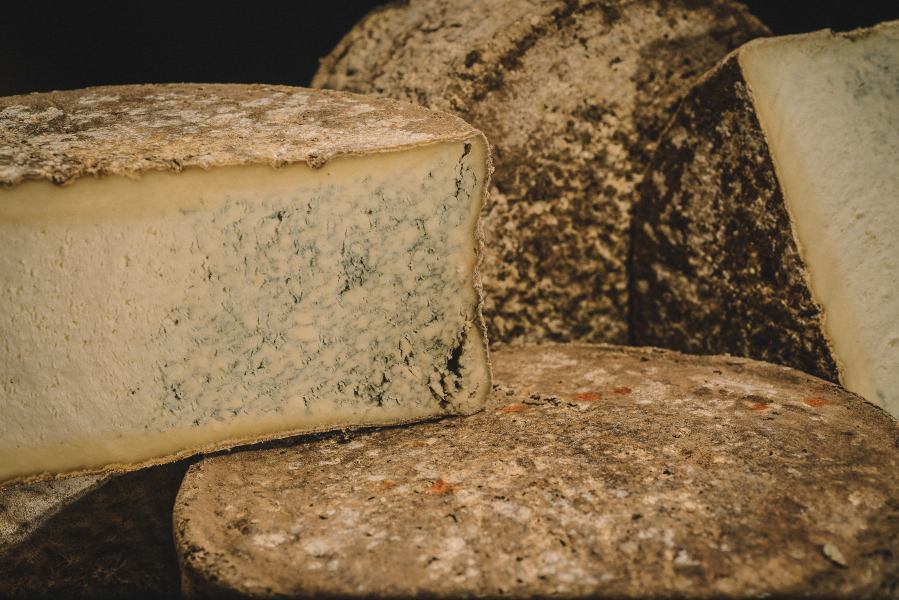
The Bleu de Termignon is a unique and rare cheese with a rich history rooted in the mountainous Savoie region of eastern France. Its story begins in the small village of Termignon, nestled near the Italian border in the picturesque French Alps.
The origin of this cheese dates back to ancient times when it was known as “morianinghi” or “mauriennais”. Unlike many other cheeses from the Savoie region that were traditionally made with a mix of cow, goat, and sheep milk, Bleu de Termignon has always been a pure cow’s milk cheese. This distinction helped it stand out in a robust competition of regional cheeses and started its journey towards popularity.
The production of Bleu de Termignon is a testament to the preservation of traditional cheesemaking methods. It is handcrafted by only a few dedicated farmers from June through September using milk from Tarine and Abondance cows. The cheese is then aged for several months in cool cellars, resulting in a final product that is a true reflection of its terroir.
Bleu de Termignon is known for its unique flavor profile. Its taste is complex and layered, offering a delicate balance between the sweetness of the milk and the sharpness of the blue mold. The texture is crumbly yet creamy, and the aroma is reminiscent of fresh grass and wildflowers.
This cheese has had several key moments that helped shape its legacy. One of them is its comparison to the methodology of Mozzarella and Gorgonzola production, which has brought international attention to this humble cheese. Despite its rarity, Bleu de Termignon has managed to carve out a niche for itself in the world of gourmet cheeses, attracting the attention of food connoisseurs from around the globe.
Today, Bleu de Termignon holds a significant cultural importance. It is not just a cheese; it is a symbol of heritage, tradition, and the artisanal spirit of the French Alps. It is enjoyed in its pure form, paired with fruits, nuts, and a variety of beverages, and used in gourmet cooking. Despite its scarcity, it continues to be sought after by cheese lovers in France and abroad, adding to its mystique and allure.
In conclusion, the story of Bleu de Termignon is a testament to the power of tradition, patience, and craftsmanship. It serves as a reminder that some things are worth preserving, not just for their taste but for what they represent – a slice of history, a sense of place, and a commitment to quality.
More Cheeses from France:
